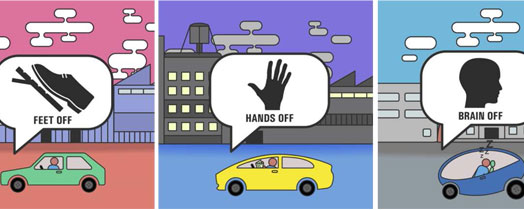Autonomous driving: emergence of new billion euro market

"Value of Time" study analyzes the market potential for value-added services in self-driving cars Fraunhofer IAO / Horváth & Partners 2016
How much are motorists prepared to pay for value-added services in an autonomous vehicle? This is the question posed by management consultants Horváth & Partners and the Fraunhofer IAO in their joint study “The Value of Time – Potential for user-centered services offered by autonomous driving”.
The result is remarkable. An average willingness to pay of between 20 and 40 euros per month was calculated for each of the six categories of need, i.e. communication, productivity, basic requirements, wellbeing, information, and entertainment.
Will autonomous driving become established in the next ten years?
“Three quarters of the 1500 motorists surveyed would pay for value-added services in an autonomous vehicle,” says Ralf Gaydoul, Partner and Head of the Automotive Center at Horváth & Partners, as he sums up the findings of the project.
“We are working on the premise that autonomous vehicles will become established in the next ten years. The more popular autonomous driving becomes, the greater the demand by users for services to meaningfully utilize the time freed up in the car. If the values were to be added up across all categories of need, this would give rise to a monthly amount of well in excess of 100 euros per driver.”
Major demand for offers relating to service and communication
The willingness to pay for services is at its highest in relation to communication and productivity. “These services are the most heavily in demand in all three countries examined, though with different variations,” says Dr. Jennifer Dungs, Head of the Mobility and Urban System Design Division at the Fraunhofer IAO.
“For example, interest in in-car social media services is much higher in Japan than here in Germany (64 percent compared with 23 percent).” Accordingly, providers from different sectors can gain a significant share of sales. In addition to automobile manufacturers and suppliers, this can include manufacturers of technical devices and digital service providers. The automobile sector is also witnessing an increasing trend toward competition from companies from outside of the sector.
Whether or not motorists are willing to pay for value-added services also depends on the generation to which they belong. The willingness to pay reduces significantly from the age of 35. The daily journey time likewise plays a role. The more time a person spends in the car, the more willing he or she is to pay for the use of value-added services, however marginal the difference. The willingness to pay seems to be largely unrelated to the vehicle segment on the other hand – drivers of small cars are just as interested as drivers of mid-sized and high-end cars.
Contact
Dr. Jennifer Dungs
Fraunhofer IAO
Nobelstraße 12
70569 Stuttgart, Germany
Phone +49 711 970-2031
jennifer.dungs@iao.fraunhofer.de
https://www.iao.fraunhofer.de/lang-en/images/iao-news/studie-value_of_time_EN.pd…
https://www.iao.fraunhofer.de/images/iao-news/value-of-time-en.pdf
https://blog.iao.fraunhofer.de/car-office-statt-home-office-wie-sich-die-automat…
http://blog.iao.fraunhofer.de/category/mensch-und-mobilitaet/automatisiertes-aut…
Media Contact
All latest news from the category: Information Technology
Here you can find a summary of innovations in the fields of information and data processing and up-to-date developments on IT equipment and hardware.
This area covers topics such as IT services, IT architectures, IT management and telecommunications.
Newest articles

NASA: Mystery of life’s handedness deepens
The mystery of why life uses molecules with specific orientations has deepened with a NASA-funded discovery that RNA — a key molecule thought to have potentially held the instructions for…

What are the effects of historic lithium mining on water quality?
Study reveals low levels of common contaminants but high levels of other elements in waters associated with an abandoned lithium mine. Lithium ore and mining waste from a historic lithium…

Quantum-inspired design boosts efficiency of heat-to-electricity conversion
Rice engineers take unconventional route to improving thermophotovoltaic systems. Researchers at Rice University have found a new way to improve a key element of thermophotovoltaic (TPV) systems, which convert heat…



